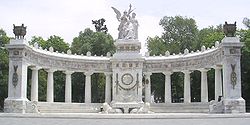
Mexico City Alameda Central
Encyclopedia

Urban park
An urban park, is also known as a municipal park or a public park, public open space or municipal gardens , is a park in cities and other incorporated places to offer recreation and green space to residents of, and visitors to, the municipality...
in downtown Mexico City
Mexico City
Mexico City is the Federal District , capital of Mexico and seat of the federal powers of the Mexican Union. It is a federal entity within Mexico which is not part of any one of the 31 Mexican states but belongs to the federation as a whole...
, adjacent to the Palacio de Bellas Artes
Palacio de Bellas Artes
The Palacio de Bellas Artes is the most important cultural center in Mexico City as well as the rest of the country of Mexico...
, between Juarez Avenue and Hidalgo Avenue.
Description
The Alameda Central park is a green garden with paved paths and decorative fountainFountain
A fountain is a piece of architecture which pours water into a basin or jets it into the air either to supply drinking water or for decorative or dramatic effect....
s and statues, and is frequently the center of civic events. The area used to be an Aztec marketplace. The park was created in 1592, when Viceroy Luis de Velasco
Luis de Velasco
Luís de Velasco was the second viceroy of New Spain during the Spanish colonization of the Americas in the mid-sixteenth century....
decided to create green space here as a public park. The name comes from the Spanish word álamo, which means poplar
Poplar
Populus is a genus of 25–35 species of deciduous flowering plants in the family Salicaceae, native to most of the Northern Hemisphere. English names variously applied to different species include poplar , aspen, and cottonwood....
tree, that were planted here. This park was part of the viceroy's plan to develop what was, at that time, the western edge of the city. It has become a symbol of a traditional Mexican park and many other parks in the country take on the name "Alameda" as well.
History
The original park was less than half the size of the current one, reaching only from where the Palacio de Bellas Artes is now to the location of the Hemiciclo de Juárez. What is now the western section of the park originally was a plain plaza built during the Inquisition in Mexico and known as El Quemadero or The Burning Place. Here witches and others convicted by the Inquisitors were publicly burned at the stake. By the 1760s, the Inquisition has nearly come to an end and in 1770, viceroy Marqués de Croix had this plaza torn up to expand the park. The park was expanded again in 1791, when the Count of Revillagigedo built a wooden fence around the park to make it exclusive for the nobility. However, when Mexican Independence was won in 1821, the Alameda was the center of popular celebrations. In 1846, when President Santa Anna rode triumphantly into Mexico City, he ordered the fountains in the park be filled with alcohol.The five classical fountains are of French design and inspired by Greco-Roman mythology. More statues were added to the park in the 19th century. Gas lamps were installed in 1868, which were replaced by electrical lighting 1892. By the end of the 19th century, the park had become popular with all social classes in Mexico. Much of the current layout of the park, with its starburst pattern of paths around fountains and the central kiosk dates from the late 19th and early 20th centuries.
By the late 19th century, the park included a bandstand
Bandstand
A bandstand is a circular or semicircular structure set in a park, garden, pier, or indoor space, designed to accommodate musical bands performing concerts...
and gas (now electric) lamps. On the south side of the park, facing toward the street is the Hemiciclo a Juárez, which is a large white semi-circular monument to Benito Juárez
Benito Juárez
Benito Juárez born Benito Pablo Juárez García, was a Mexican lawyer and politician of Zapotec origin from Oaxaca who served five terms as president of Mexico: 1858–1861 as interim, 1861–1865, 1865–1867, 1867–1871 and 1871–1872...
, who is one of Mexico's most beloved presidents.
The park's statues include Despoire and Malgre Tout, by Jesús Contreras, and a monument donated by the German
Germany
Germany , officially the Federal Republic of Germany , is a federal parliamentary republic in Europe. The country consists of 16 states while the capital and largest city is Berlin. Germany covers an area of 357,021 km2 and has a largely temperate seasonal climate...
community which is dedicated to Beethoven in commemoration of the centenary of his 9th Symphony
Symphony No. 9 (Beethoven)
The Symphony No. 9 in D minor, Op. 125, is the final complete symphony of Ludwig van Beethoven. Completed in 1824, the symphony is one of the best known works of the Western classical repertoire, and has been adapted for use as the European Anthem...
.
Access
Alameda Central can be accessed by Metro Bellas ArtesMetro Bellas Artes
Metro Bellas Artes is a station along Line 2 and Line 8 of the Mexico City Metro system. It is located in the Colonia Centro district of the Cuauhtémoc borough of Mexico City, on the junction of Avenida Juárez and Eje Central Lázaro Cárdenas, on the eastern end of the Alameda Central, west of the...
.

